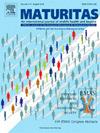Intravaginal prasterone for urinary urgency in postmenopausal women without urodynamic detrusor overactivity
IF 3.6
2区 医学
Q2 GERIATRICS & GERONTOLOGY
引用次数: 0
Abstract
Objectives
Symptoms of an overactive bladder are frequently reported in women with genitourinary syndrome of menopause. Despite a frequent association with detrusor overactivity, urodynamic assessment does not always reveal this condition, which suggests a leading role for increased bladder mucosal sensitivity due to hormone deprivation in producing urinary symptoms. The present study assessed the effects of intravaginal prasterone on urgency symptoms in those patients receiving treatment for concurrent vulvovaginal atrophy.
Study design
This was an observational cohort study on 21 women with genitourinary syndrome of menopause, including urgency symptoms, without detrusor overactivity on urodynamic assessment. Patients received intravaginal prasterone 6.5 mg daily and were reassessed at 12 weeks.
Main outcome measures
Urinary symptoms and their impact on the quality of life were evaluated through the Urogenital Distress Inventory (UDI-6) and Overactive Bladder short-form (OAB-Q SF) questionnaires; secondary outcomes included urinary frequency and prevalence of urgency or incontinence as recorded in a voiding diary, and scores on a visual analogue scale (VAS) for vaginal discomfort.
Results
A significant improvement in urinary symptoms was observed in the scores on both the UDI-6 (57.1 +/− 20.7 vs 30.2 +/− 22.7, p < 0.001) and the OAB-Q SF (61.3 +/− 19.7 vs 35.7 +/− 22, p < 0.001); a significant improvement was also reported in terms of better quality of life, diminished VAS scores, and a reduction in incontinence and daily and nocturnal frequency.
Conclusions
Women complaining of urgency related to genitourinary syndrome of menopause with no urodynamic evidence of detrusor overactivity may benefit from treatment with intravaginal prasterone.
阴道内用普睾酮治疗无尿动力逼尿肌过度活动的绝经后妇女尿急
目的:绝经期泌尿生殖系统综合征患者经常出现膀胱过度活动的症状。尽管尿频与逼尿肌过度活动有关,但尿动力学评估并不总是显示这种情况,这表明激素剥夺导致膀胱黏膜敏感性增加在产生泌尿系统症状中起主导作用。本研究评估阴道内使用普睾酮对并发外阴阴道萎缩患者急症症状的影响。研究设计:这是一项观察性队列研究,纳入21名绝经期泌尿生殖系统综合征女性,包括急症症状,尿动力学评估无逼尿肌过度活动。患者每天接受阴道内注射6.5 mg,并在12周时重新评估。通过泌尿生殖窘迫问卷(UDI-6)和膀胱过度活动简短问卷(OAB-Q SF)评估泌尿系统症状及其对生活质量的影响;次要结局包括尿频和尿急或尿失禁的发生率,记录在排尿日记中,并在视觉模拟量表(VAS)上对阴道不适进行评分。结果UDI-6评分(57.1 +/ - 20.7 vs 30.2 +/ - 22.7, p <;0.001)和OAB-Q SF (61.3 +/ - 19.7 vs 35.7 +/ - 22, p <;0.001);在生活质量改善、VAS评分降低、尿失禁以及日常和夜间频率减少方面也有显著改善。结论在没有尿动力学证据表明逼尿肌过度活动的情况下,抱怨与绝经期泌尿生殖系统综合征相关的急症的妇女可能受益于阴道内用普酮治疗。
本文章由计算机程序翻译,如有差异,请以英文原文为准。
求助全文
约1分钟内获得全文
求助全文
来源期刊

Maturitas
医学-妇产科学
CiteScore
9.10
自引率
2.00%
发文量
142
审稿时长
40 days
期刊介绍:
Maturitas is an international multidisciplinary peer reviewed scientific journal of midlife health and beyond publishing original research, reviews, consensus statements and guidelines, and mini-reviews. The journal provides a forum for all aspects of postreproductive health in both genders ranging from basic science to health and social care.
Topic areas include:• Aging• Alternative and Complementary medicines• Arthritis and Bone Health• Cancer• Cardiovascular Health• Cognitive and Physical Functioning• Epidemiology, health and social care• Gynecology/ Reproductive Endocrinology• Nutrition/ Obesity Diabetes/ Metabolic Syndrome• Menopause, Ovarian Aging• Mental Health• Pharmacology• Sexuality• Quality of Life
 求助内容:
求助内容: 应助结果提醒方式:
应助结果提醒方式:


